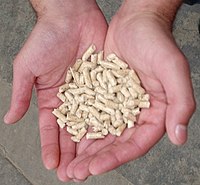
Photo from wikipedia
Abstract Increasing energy demands and waste management concerns have motivated agricultural producers to consider the decentralized conversion of agricultural by-products for energy and value-added product (biochar) generation. Due to the… Click to show full abstract
Abstract Increasing energy demands and waste management concerns have motivated agricultural producers to consider the decentralized conversion of agricultural by-products for energy and value-added product (biochar) generation. Due to the variability of fuel properties, direct combustion of agricultural by-products with high ash contents, such as rice husk, may suffer from increased fouling and slagging issues with high particulate matter (PM) emissions. Combustion of the raw pyrolysis volatiles (bio-oil and synthesis gas (syngas) mixtures) produced from pyrolysis with the inherent separation of ash in the biochar may potentially mitigate these issues. In this study, PM emissions from the combustion of the raw pyrolysis volatiles derived from the pyrolysis of rice husk were evaluated at laboratory scale by using a combined pyrolysis and combustion facility. Pyrolysis temperatures ranging from 400 °C to 800 °C were used to generate raw pyrolysis volatiles with differing bio-oil to syngas ratios which were then combusted at 850 °C. It was found that bio-oil dominated the higher heating value of the raw pyrolysis volatiles produced at low pyrolysis temperatures. The combustion of such raw pyrolysis volatiles with high bio-oil content substantially increased the yields of PM 10 and PM 2.1 . Linear dependence was observed between PM emissions and bio-oil fraction in the raw pyrolysis volatiles. Nevertheless, the pyrolysis-combustion process, with >96% of the ash retained in biochar prior to combustion, is more favorable than direct combustion for high ash biomass as far as PM emissions are concerned.
Journal Title: Journal of Cleaner Production
Year Published: 2018
Link to full text (if available)
Share on Social Media: Sign Up to like & get
recommendations!